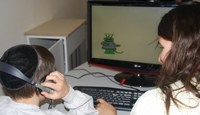Learning to read comes at a cost

Starting Big
Adults typically have problems with learning grammatical relations such as agreement between nouns and their gendered articles (is the Spanish word for problem ‘la problema’ or ‘el problema’?). Young children are much better at learning such arbitrary relations among words. Children’s superior learning skills may be due to their age and brain flexibility. However, according to Naomi Havron and her colleagues, children’s advantage in grammar learning may also be due to their inability to read. This idea is based on Inbal Arnon’s Starting Big hypothesis, which states that younger children are better learners because they focus more on multiword units and less on individual words. The researchers predicted that children should excel at learning certain grammatical relations between words before they become literate. After learning how to read, they should pay more attention to single words, which hinders learning relations between words.
An alien language
To test children’s learning abilities, the researchers created a new language. This artificial language contained eight new nouns for existing items, such as “keba” for clock and “nadi” for chair, paired with one of two new ‘gender articles’: “do” or “ga”. On screen, a green cartoon alien with three eyes would point at the object and say the alien equivalent of “this is the clock” (e.g. “kamek do keba”). All sentences started with “kamek” followed by a pause, but there was no pause between the article and noun. A group of 31 first graders (6-year-olds) and 27 third graders (8-year-olds) from schools in Israel listened to all sentences in the alien language for about four minutes.
The researchers then tested the children on vocabulary (nouns) and grammar (gender agreement relations). To test vocabulary, the alien would use the wrong label (calling a clock a “nadi”). To test grammar, the alien would use the wrong gender article (calling a chair “do nadi” instead of “ga nadi”). In each trial, the alien would utter both the correct and the incorrect sentence (e.g. “kamek ga nadi” and “kamek do nadi”), after which children had to decide on the correct one. All children were tested again after six months, during which time the first graders had learned how to read. For the second testing session, the researchers used a similar language with a new set of gender articles and nouns. Would literacy affect the 6-year-olds’ learning patterns?
The effect of literacy
The preliterate 6-year-olds were better at learning grammatical relations than at learning nouns. Their score on grammatical relations was well above chance (64% correct), while their performance on nouns was at chance (50% correct). The 8-year-olds were equally good at learning grammar and vocabulary, scoring above 65% correct in both sessions. After only six months of reading instruction, the first graders showed the same pattern as the third graders. The now literate 6-year-olds performed equally well on grammatical relations (61% correct) and nouns (57% correct). As expected, their grammatical agreement advantage had disappeared after learning to read.
The researchers conclude that literacy affects the way children learn a new language, and may come at a cost. According to first author Naomi Havron and MPI’s Limor Raviv, this finding has implications for second language teaching: exposure to written input can help word learning, but may harm some aspects of grammar learning. Although learning to read has many benefits, the authors argue that “there are advantages to learning a new language before you can read”.
Share this page